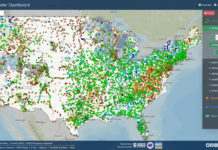Whether it’s taking my pick of one out of 10,000 lakes on my Independence Day holiday road trip, or floating down the Missouri River back home, the presence of freshwater is a major part of my summer and presumably that of any other boater or angler enjoying the warmer temperatures of the season. Casting for bass, trolling for walleyes or fly fishing for trout and sunfish all require access to a stream, river, or lake and involve access to that water. On top of abundance, that water must be clean enough to support fish life and the food web that sustains those sport species. Taking a pause in between casts and stepping back to admire how lucky we are to have such golden summer opportunities can lead one down a rabbit hole that further stresses just how rare our fishable waters are.
One of the earliest geological facts taught in school is that the Earth’s surface is roughly 70 percent water. There’s about 330 million cubic miles of it covering the planet, which in print doesn’t seem like a lot, but think of a section of land with a mile of water stacked on top of it. Then think of 330 million of those. Of that amount of 330 million mile-high water cubes, about 97 percent of them are saltwater. That leaves about three percent as freshwater, with a minority of that reduced percentage comprising our lakes, streams, swamps, and creeks with most of it locked up in glaciers and ice sheets worldwide. When it comes down to it, less than one half of one percent of the world’s water makes up the lakes and rivers we fish and recreate on, and while they may seem abundant in a two-hour drive and discussed with a tone as casual as where the most recent walleye bite is happening, their rarity, in light of what a small fraction of the world’s water they are, cannot be understated.
To put it in perspective, I have a friend in Pipestone County in southwestern Minnesota, that when I met him for the first time, he introduced himself and where he was from, with the addition of “one of the four counties in the land of 10,000 lakes that doesn’t have one.” From the outset of our discussion at the statewide convention for conservationists, his comment stuck with me, as everywhere I’ve lived in both North Dakota and Minnesota has had at least a dozen fishable lakes, streams, and rivers within 20 miles of my house. How unfortunate that fate would land this fellow hunter and angler in a spot where he’d have to drive three times that distance to find a fishable water. Placing that piece in the puzzle of freshwater percentages — or thinking of places like the Sahara Desert, or even reviewing what’s happening in the southwestern United States — and those who live within minutes of a place where they can wet a line and enjoy time on life-sustaining freshwater, are truly lucky.
In the last 300 years or so, we’ve done our best to exploit those limited freshwater oases in the name of progress and profits, dumping chemicals, plant waste, and overfishing them to the point they were almost devoid of life. Whether it was the east coast acid rain in the 1970s and ’80s from industrial emissions that destroyed fragile brook trout fisheries in the Appalachian Mountains, or the paper mulch and chemicals that clogged the Rainy River a century ago and nearly extirpated the once abundant lake sturgeon in the flow along the Minnesota-Canada border, the impacts we have had on these truly rare waters and others are frustrating, even heart-wrenching.
But one of the wonders of freshwater and the creatures that live in it, and really all the natural world, is that given a chance and the attention they need, no matter how small or how abrupt the turn around is, they can and will come back if a foothold is a possibility. With that knowledge of what we can do and have done to reverse our impact, and limit it going forward so that no razor’s edge dividing line need be experienced by our waters — and seeing the return of brookies to the creeks of the eastern mountains, and the resurgence of sturgeon on the Rainy River, and hundreds of other wins for the conservation of freshwater fisheries across the continent — we are better able to take that step back and do what must be done to preserve the opportunities (if we’re lucky) that are just outside our back door.
As we enter the back half of summer, take a breather in between casts to appreciate the truly amazing nature of any freshwater. From that 40-acre prairie lake with the brand-new boat ramp, to the vast expanse of Lake Superior, to the comparative trickle holding an evening’s worth of walleyes or smallmouth bass flowing through town, each one is rare, each one is important, and each one is worthy of protection. That responsibility falls to all of us, from putting garbage where it belongs, to assessing drainage issues, to monitoring the quality of our flows and their fish populations. It is through these efforts and the recognition of how important their rewards are that we understand our impact on these waters, and their continued impact on us and that portion of our lives spent … in our outdoors.
Credit: Source link






























